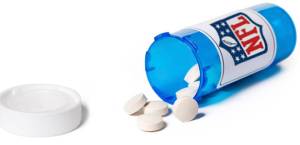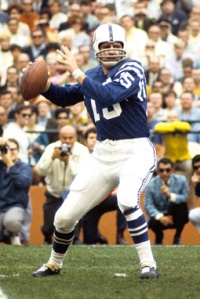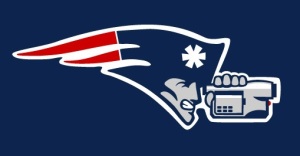With the 2014 NFL season upon us, Enter the Razorback decided to take a different approach in covering kickoff week. The list below profiles some of the league’s most noteworthy — and plausible — conspiracy theories.
10. Jimmy Hoffa was buried under Giants Stadium
The infamous union activist disappeared in 1975, around the same time construction was underway on Giants Stadium. Based on accounts from hitmen allegedly involved with Hoffa’s death, they dismembered his body before dropping the remains inside a concrete drum located at the construction site. Mythbusters investigated the rumors and came up empty. But if Hoffa’s body wasn’t there, how else do you explain Jerry Rice’s fumble in the ’86 playoffs?
9. Dome teams pump in crowd noise
Now that domed stadiums are ubiquitous across the NFL, accusations that teams pump in artificial noise have increased tenfold. Numerous coaches and players complain about the nuisance, which dates back to the late 1980s when the Minnesota Vikings’ Metrodome drew unwanted attention for its ear-splitting cheers.
More recently, the Indianapolis Colts, were charged with pumping in noise during the 2007 season. Despite the peculiar sounds coming through fans’ TV screens, the Colts were cleared of any wrongdoing on the dubious explanation that it was a technical glitch inside the RCA Dome.
8. Pro football is rife with Adderall abuse
 The Seattle Seahawks have taken the brunt of negative headlines regarding NFL players testing positive for Adderall. The drug, which is primarily used to treat attention deficit disorders and narcolepsy, can also serve as a “cognitive enhancer.” It’s become a popular supplement for players looking to gain an “edge” on game day.
The Seattle Seahawks have taken the brunt of negative headlines regarding NFL players testing positive for Adderall. The drug, which is primarily used to treat attention deficit disorders and narcolepsy, can also serve as a “cognitive enhancer.” It’s become a popular supplement for players looking to gain an “edge” on game day.
Recent busts involved two of Seattle’s high-profile defensive stars, Bruce Irvin and Richard Sherman. Both players took Adderall looking for the upper-hand over the competition. Trying to deflect attention, Sherman claimed that “half the league uses Adderall.” A ominous statement for sure, but there have been a significant number of suspensions tied to the use of similar amphetamines over the last five years.
7. Does the NFL “hate” the Oakland Raiders?
Talk to any Raiders fan and you’ll hear endless stories about how the NFL has a grudge against Oakland. And evidence suggests that Raider Nation has a legitimate gripe.
For starters, there was a well-known rivalry between longtime Raiders owner Al Davis and former NFL Commissioner Pete Rozelle. There were endless stories (usually one-sided) that Rozelle did everything in his power to undermine Davis, which culminated in a heated legal battle when Oakland tried to move to LA. But Davis didn’t make things easy. The abrasive owner drew the ire of the NFL in the late 60s, when he spurred a bidding war between the rival leagues. There’s also the issue of the 1983 NFL draft, when the Raiders failed to land John Elway and Davis blamed it on meddling by league officials.
More recent accusations have been hurled thanks to the infamous “Tuck rule” and examples of questionable officiating that have hindered Oakland’s success.
6. Super Bowl III was fixed
 It would be a travesty if the biggest upset in NFL history was actually a well-crafted ploy to drum up support for the AFL-NFL merger. But over the last four decades, Super Bowl III has been the target of several conspiracy theories, namely that it was rigged.
It would be a travesty if the biggest upset in NFL history was actually a well-crafted ploy to drum up support for the AFL-NFL merger. But over the last four decades, Super Bowl III has been the target of several conspiracy theories, namely that it was rigged.
Colts fans often point to the bizarre interception(s) thrown by quarterback Earl Morrall, as evidence of foul play. Morrall, who was the MVP of 1968, missed a wide-open Jimmy Orr, who was waving his hands in the end zone late in the first half. Former Colts players have chimed in as well, claiming that the New York Jets needed to win to keep the AFL afloat. Bubba Smith, Baltimore’s Pro Bowl defensive end, possibly referring to the looming merger, that there was too much money at stake for the Jets to lose.
There’s also allegations that Colts owner Carroll Rosenbloom bet against his own team and that Jets quarterback Joe Namath was urged by the mafia to throw the game.
5. The NFL orchestrated the “Blackout Bowl”
The Baltimore Ravens put a stranglehold on the San Fransisco 49ers in Super Bowl XLVII. And with the Ravens leading 28-6 early in the second half, a Baltimore victory seemed to be little more than a formality.
Then the unexpected happened.
The Louisiana Superdome suffered a power outage, resulting in a 34-minute delay. The break revitalized the 49ers, who scored 17 unanswered points. San Fransisco’s incredible comeback turned the game from a blowout into a nail-biter. This sudden shift in momentum kept the NFL from losing viewers, and thus billions in advertising dollars — or so one theory says.
While Baltimore held on for a thrilling victory, current and former Ravens players contend the NFL was plotting against them. Hall of Fame linebacker Ray Lewis said the blackout happened to make the game more competitive; meanwhile, teammate Terrell Suggs claimed NFL commissioner Roger Goodell used “parlor tricks” because of a personal bias against Baltimore.
Other theories cast a large net of blame, citing everyone from irate New Orleans Saints and 49ers fans, to Bane and Beyonce as the true culprits.
4. LA is just a bargaining chip
When the Raiders and Rams departed Los Angeles in the mid 1990s, the possibility of SoCal recouping a pro football team has been a never-ending saga of letdowns. It seems every other season a well-established franchise is on the brink of moving to LA.
Usually, the threat is spurred by the team wanting a new stadium (with a lot of help from the taxpayers). Over the past decade, cities routinely caved and agreed to help fund new facilities. But do these stadium deals really just serve to keep teams in their original or current cities. In fact, what if moving to LA is just a threat that owners agreed could be used to hold cities (and their taxpayers) on the hook for construction expenses?
Some writers are convinced the NFL has left LA for good. Empty threats from owners (the last franchise to relocate was the Houston Oilers, which moved from Houston to Nashville in 1997 to become the Tennessee Titans), the NFL’s unapologetic plans to put a franchise in Europe and Goodell’s reticence to commit a team to the region give this theory credence.
3. Spygate was worse than we thought
 Not long after Goodell took over as commissioner, news broke in fall 2007 that the New England Patriots had videotaped the New York Jets’ signal calls during a recent game. Those who viewed the tapes said it gave the Patriots an unfair advantage, but the real news stemmed from complaints that the Pats had been videotaping their opponents for years, including the St. Louis Rams’ practice ahead of Super Bowl XXXVI, which New England won.
Not long after Goodell took over as commissioner, news broke in fall 2007 that the New England Patriots had videotaped the New York Jets’ signal calls during a recent game. Those who viewed the tapes said it gave the Patriots an unfair advantage, but the real news stemmed from complaints that the Pats had been videotaping their opponents for years, including the St. Louis Rams’ practice ahead of Super Bowl XXXVI, which New England won.
Since the NFL destroyed the notes and videotapes associated with Spygate not long after its investigation, some have charged the league with covering up rampant cheating by the Patriots. Another theory says that the scandal is more complex. Supposedly, this type of behavior is so widespread that New England coach Bill Belichick sent Goodell tapes from other teams videotaping their opponents’ practices. The commissioner, fearful to clamp down on systemic cheating, chose only to punish New England and protect the NFL’s image.
2. The ’99 Browns were “set up to fail”
In 1995, the NFL expanded to 30 teams when it added the Carolina Panthers and Jacksonville Jaguars. Both teams quickly found success, reaching their respective conference championships the following season. Their meteoric rise — unprecedented for expansion teams — allegedly rankled owners of more established clubs. So when Cleveland regained a franchise in 1999, established NFL owners conspired to curb the Browns’ efforts to field a competitive team.
The theory, postulated by former Cleveland sports writer Terry Pluto, is one of the most well-researched entries on the list. Backed up by loads of peculiar evidence, which includes numerous examples of roadblocks the Browns faced thanks to the league’s other owners, the theory’s implications are startling. It serves as an explanation as to why the Browns have struggled mightily since rejoining the NFL. And while it doesn’t totally absolve the Browns of their failures since returning to Ohio, it certainly explains some of their early hurdles.
1. Who was New England’s “man in the trench coat”?
NFL fans would have a hard time recognizing the New England Patriots in their formative years.
Known as the Boston Patriots for the first decade of their existence, the club only made one playoff appearance between 1960-1970. The Pats wouldn’t appear in a Super Bowl until the 80s, and nearly 20 more years would pass before they became one of the dominant franchise of the modern era.
One thing those early Patriots teams did have going for them was sterling fan support. Playing inside the constricted confines of Fenway Park, fans were often right on top of the action. It wasn’t uncommon for fans to stand along the sidelines during a game or pat players on the back near the team benches. And in 1961, one fan took advantage of that unfettered access, helping the Pats pull off a much-needed victory.
The unknown fan, identified only by his trench coat, was standing directly behind the opponent’s end zone during the game’s waning minutes. With New England leading the Dallas Texans 28-21 late in the fourth quarter, the Texans were threatening at the Patriots goal line. But as Dallas’ Cotton Davidson dropped back to pass, the overzealous fan sprinted onto the field and deflected the ball. As soon as the ball hit the turf, the crowd stormed onto the field. No one, not even the officials, realized what happened until the film was reviewed nearly a week later by coaches.
The gentleman became known in Patriots lore as the “man in the trench coat.” Rumors were rampant that the fan was actually Patriots owner Billy Sullivan, who was often spotted in a similar trench coat. Sullivan embraced the publicity, never denying the rumors.
